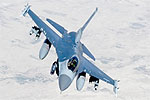AF seeks F-16 fleet upgrade, requests 19 more F-35As
 The Air Force plans to upgrade all 1,018 of its F-16s and 175 F-15C/D Eagles to keep them flying until the F-35A joint strike fighter is fully operational and new weapons systems on the F-22 Raptor are installed, according to the 2014 budget request released April 10. In the fiscal 2014 budget request, the Air Force states the service life extension for all F-16s will add eight to 10 years to each airframe, along with upgrades to the fighter’s radars, cockpit displays and other communications interfaces.
The Air Force plans to upgrade all 1,018 of its F-16s and 175 F-15C/D Eagles to keep them flying until the F-35A joint strike fighter is fully operational and new weapons systems on the F-22 Raptor are installed, according to the 2014 budget request released April 10. In the fiscal 2014 budget request, the Air Force states the service life extension for all F-16s will add eight to 10 years to each airframe, along with upgrades to the fighter’s radars, cockpit displays and other communications interfaces.
While the F-16s are being upgraded, the service is requesting funding to purchase 19 more F-35As in fiscal 2014 to add to the 11 that have already been delivered. This funding is part of a $15.7 billion request for the “global precision attack” capability, which also includes upgrades to the F-15E, B-1B Lancer, bombs and the continued development of the next-generation long-range strike bomber.
Maj. Gen. Ed Bolton, the deputy assistant secretary of the Air Force for the budget, said the planned purchases of the F-35As do not take into account the mandatory budget cuts known as sequestration, which would force the service to cut planned acquisitions of the jet.
“We’re still working out the details on exactly what the reductions will be, but it could be in the order of three to five aircraft … and so this delays an important capability that we need if we go into anti-access area denial environment,” Bolton said.
The Air Force needs 249 legacy F-15 C/Ds to continue the air superiority role, and is requesting funding to continue life-support extensions to keep the Eagles flying until 2030. As part of the $8.6 billion request for air superiority, the service is planning to upgrade the radars and displays in the 175 F-15C/D “Long Term Eagle Fleet,” according to budget documents.
Most of the request is focused on F-22 upgrades to both the training and combat-coded fleet. The combat aircraft are set to receive an upgrade to a Block 30/35 configuration, which will include advance air-to-ground and electronic attack modes for the Raptor’s radar.
The service will change the depot maintenance system for the Raptors now that all 187 have been delivered, along with a new program to continuously evaluate the F-22 fleet. The program, called the Reliability and Maintainability Maturation Program, is designed to avoid situations such as the 2011 five-month grounding caused by malfunctions in the jet’s life support system and continued corrosion control efforts on the Raptor’s stealth coatings.
While these fixes and changes are underway, the Air Force will continue test and development on new weapons systems and ways to integrate them on the Raptor, including the AIM-9X missile. The missile allows a pilot to lock on to a target after firing with the goal to decrease the time required from identification to firing. The service also is investing in development of the AIM-120D missile — the next iteration of the currently fielded medium-range anti-air missile, with longer range and increased radar capability.
F-22 basing is expected to be finalized following the delay of the move of a combat-coded squadron from Holloman Air Force Base, N.M., to Tyndall Air Force Base, Fla. The move was planned in fiscal 2013 but was put on hold, and then ultimately delayed a year, after Congress put a complete freeze on the service’s force structure changes.